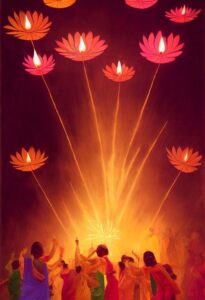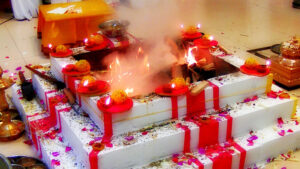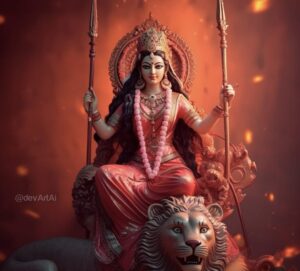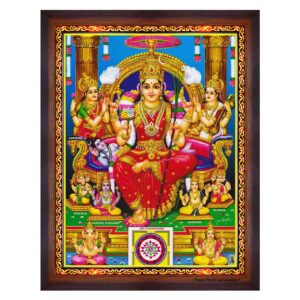The Divine Emergence of Bala Tripura Sundari
In the heart of Navaratri celebrations, where every day unfolds a new chapter of divine glory, we find ourselves entranced by the radiant forms of the goddess. If you’ve been following along, you’ve already discovered the enchanting tale of Shailaputri. But as the sun sets in the South, another intriguing avatar takes the center stage – Bala Tripura Sundari.
It’s time to embark on a journey into the mystical realm of this divine maiden, discovering her unique significance and the spiritual treasures she bestows upon her devotees. South India invites us to explore the lesser-known story of Bala Tripura Sundari, an avatar drenched in grace, beauty and profound wisdom. Join me on this captivating journey as we unravel many layers of her enchanting narrative.
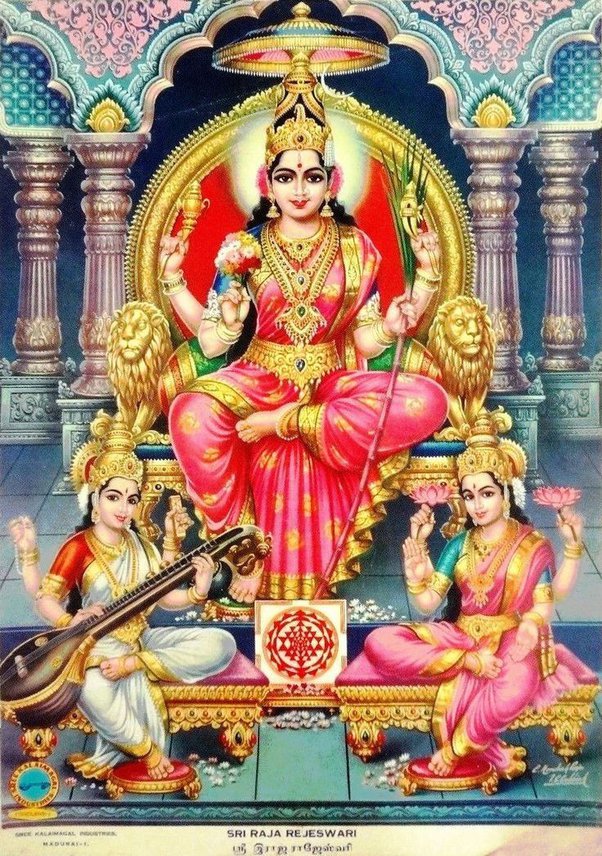
In the realm of gods and goddesses, there lived a magnificent deity named Tripura Sundari. She was a remarkable blend of beauty and wisdom, shining more brilliantly than the sun itself. Even the gods admired her wisdom.
The Mighty Asura Tarakasura:
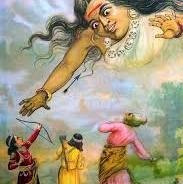
On the earthly plane, a powerful demon named Tarakasura was causing chaos. He had been granted a boon that made him nearly invulnerable, but with one condition: he could only be defeated by a child born to Lord Shiva and Parvati.
The Divine Union:
Understanding the situation, the gods implored Lord Shiva and Parvati to unite and bring forth a child who could defeat Tarakasura. Parvati, appearing as Tripura Sundari, gracefully accepted their plea. In this form, she manifested as a beautiful and wise sixteen-year-old maiden, epitomizing the pinnacle of feminine grace and knowledge.
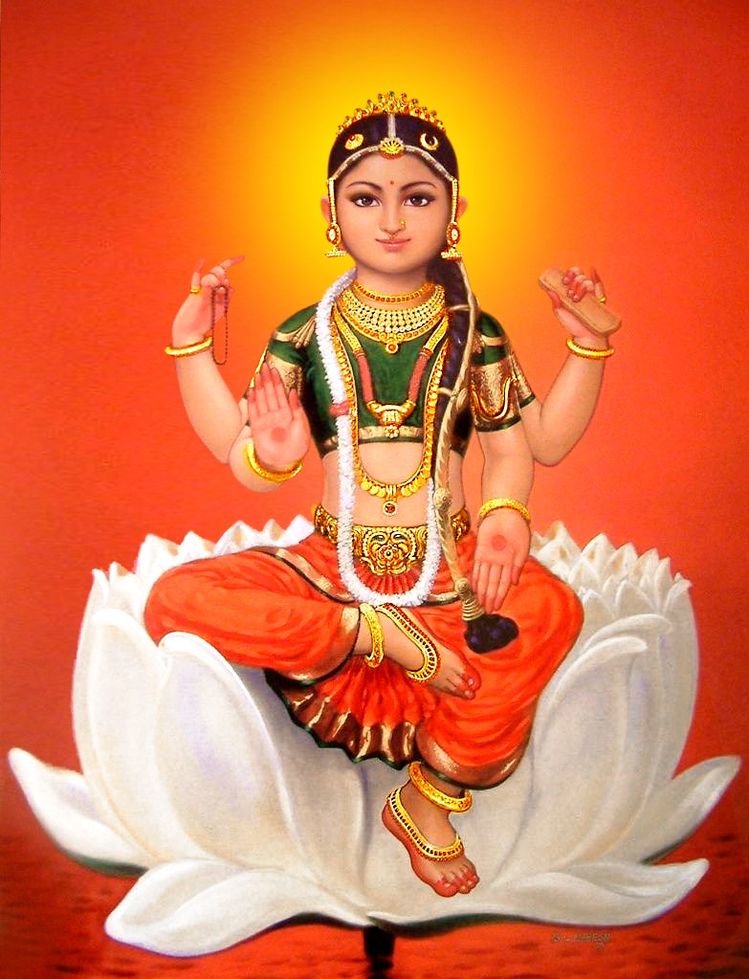
With a divine union, Shiva and Parvati welcomed the birth of Bala Tripura Sundari. She arrived into the world bearing a third eye on her forehead, symbolizing her profound wisdom and spiritual insight.
The Defeat of Tarakasura:
As Bala Tripura Sundari grew, her beauty and wisdom became even more enchanting. She assumed the guise of a young girl and engaged with Tarakasura, who had become utterly captivated by her.
In a mesmerizing moment of distraction, the young goddess revealed her divine form, engulfing Tarakasura in a radiant blaze. It was then that she utilized her divine powers to kill him, restoring cosmic harmony and equilibrium.
The Significance of Bala Tripura Sundari:
The story of Bala Tripura Sundari represents the victory of divine wisdom, beauty and grace over the forces of ignorance and arrogance. She is the embodiment of Shakti, the divine feminine energy and a source of supreme knowledge and spiritual realization.
In South India, devotees hold Bala Tripura Sundari in profound reverence, seeking her blessings for wisdom, beauty and inner enlightenment. Her tale is a powerful proof to the influence of the divine feminine, maintaining the balance of the cosmos and guiding her followers towards spiritual awakening.
Another tale related to Bala Tripura Sundari:
Let’s explore the enchanting myth of Bala Tripura Sundari.
Bala Tripura Sundari, a youthful and alluring form of the divine mother, came into being under extraordinary circumstances. She was born as the daughter of the revered sage Mathanga, a devout devotee of the goddess Shakthi. Mathanga’s unwavering dedication and penance invoked the blessings of the divine mother, leading to the birth of Bala Tripura Sundari.
Right from her inception, Bala Tripura Sundari exuded a divine radiance, embodying beauty, grace and wisdom. Her lustrous hair flowed like shimmering moonbeams, her eyes sparkled with the knowledge of the cosmos and her laughter resonated with joy throughout the universe.
But Bala Tripura Sundari was not only a symbol of beauty and innocence; she had a higher calling. Her divine mission was to confront the evil forces threatening the cosmic balance. With unwavering determination and a heart filled with compassion, she embarked on her sacred quest.
On her journey, she encountered the formidable demon, Bandasura. This demon, driven by arrogance and malice, had wreaked havoc across the realms. Bala Tripura Sundari, with her innate wisdom, wielded her divine weapons and radiant form to subdue the demon.

In a breathtaking display of divine power and grace, she emerged visctorious, symbolizing the victory of goodness over evil. Her celestial light bathed the universe, restoring peace and harmony to all.
The myth of Bala Tripura Sundari shines a light on the profound wisdom and power of the divine feminine. She is not just a goddess of beauty; she embodies inner strength, compassion and the ultimate victory of good over darkness. Her story continues to inspire and guide spiritual seekers, inviting them to explore the depths of beauty and wisdom within themselves.
Let’s explore the elements that make up her iconic image:
Iconic Form: Bala Tripura Sundari is often shown as a young girl, symbolizing the fresh and pure aspects of existence. Her image embodies the essence of youth and the unspoiled nature of the divine.
Attire: Bala Tripura Sundari is typically adorned in resplendent attire. She wears vibrant silk garments, often in shades of red or light baby pink, symbolizing love and passion. She is bedecked with jewelry, including necklaces, bangles and anklets, signifying her divine and royal status. Her flowing hair is an emblem of her free spirit and untamed energy.
Lotus Seat: Bala Tripura Sundari is often depicted seated on a lotus, a symbol of purity and enlightenment. The lotus represents her transcendence beyond the material world and her ability to rise above worldly attachments.
Four Arms: The goddess is usually shown with four arms, each holding specific objects. In one hand, she holds a noose (pasha), symbolizing her control over worldly desires. Another hand carries a goad (ankusha), representing her ability to steer and discipline the mind. The other two hands offer blessings and gestures of fearlessness, assuring devotees of her protection and grace.
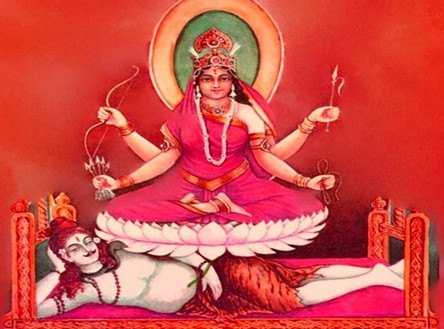
Radiant Smile: Bala Tripura Sundari’s effervescent and cheerful demeanor is often captured with a radiant smile. Her joyful expression signifies the pure and boundless joy that can be found in spiritual realization.
Third Eye: In some depictions, Bala Tripura Sundari is portrayed with a third eye on her forehead. This eye symbolizes her heightened awareness and perception of the cosmos. It represents her ability to see beyond the physical world into the realm of the spiritual.
Conch and Book: In some representations, she holds a conch shell (shankha) and a book (pustaka). The conch represents the divine sound that emanates from the heart, while the book signifies the pursuit of knowledge and wisdom. These symbols underscore her role as a bestower of spiritual insight.
Significance: Bala Tripura Sundari’s iconography embodies her qualities of purity, grace and wisdom. Her youthful form serves as a reminder of the eternal freshness and innocence of the soul. The symbols and attributes she holds convey her capacity to lead devotees towards spiritual enlightenment, steering them away from worldly attachments and desires.
Astrological Connection:
When we dive into the world of astrology, Bala Tripura Sundari’s influence is like the twinkle of a cosmic gem. As the celestial overlord of Planet Mercury, she doesn’t just strengthen the forces this planet represents in your astrological chart; she conducts a celestial orchestra that transforms the capricious dance of planetary forces into a harmonious symphony.
Consider her as a celestial guide, orchestrating the intricate dance of fate with skill. She delicately weaves the complexities of life into a harmonious melody, resonating with the promise of a life enriched by grace and abundance. In the realm of astrology, she takes on the role of a master, elegantly directing the movements of the planets to align in your favor.
Now let us see how we worship or perform pujas to this avatar in South India.
Puja Vidhi or Method of Worship: On the auspicious first day of Navaratri, the devotees embark on a sacred journey by setting the stage with a ritual as intricate as it is symbolic. Nine Kalashas take center stage, each as an embodiment of one of the nine divine avatars of the Devi. These Kalashas, vessels of purity echo the presence of each celestial form. These will be there throughout the nine days.
Neem Trees dug in mud:
Among the revered trees entwined with the worship of Goddess Durga, the Neem tree stands as a symbol of utmost respect and profound significance. Renowned for its myriad medicinal properties, the Neem tree is a sanctuary of healing, offering remedies for many ailments. This tree is not merely a botanical wonder but is deeply interwoven with spiritual beliefs.
The Neem tree is intricately connected with the divine energy of Goddess Durga herself. Many hold the conviction that the presence of Neem trees helps shield against malevolent forces and wards off evil spirits. It’s not just a tree; it’s a guardian, a sentinel against negativity and a testament to the unbreakable bond between nature, spirituality, and the protective embrace of the goddess.
These two sturdy trees, deeply rooted in the earth, are placed beside the Devi’s idol. These saplings hold the promise of growth and it is believed that the higher they rise, the stronger the aura of the Devi pervades the space. They signify the very essence of life and fertility, invoking the blessings of the goddess.
Akhanadam: As the devotional fire of Akhandam flickers near the Devi’s idol, it represents the unceasing presence of divine energy. It’s a beacon of unwavering faith that guides the seekers on their spiritual quest throughout the night. Akhandam, the eternal flame, serves as a reminder of the ever-burning light of devotion that illuminates the path of the faithful, even in the darkest hours.

Prasadam for Bala Tripura Sundari: Pulagam is a traditional Andhra rice delicacy crafted from the finest rice, moong dal, and a pinch of salt. This humble yet nutritious dish is a celebration of simplicity and purity. It pairs wonderfully with the rich flavors of coconut chutney or the earthy notes of peanut chutney.
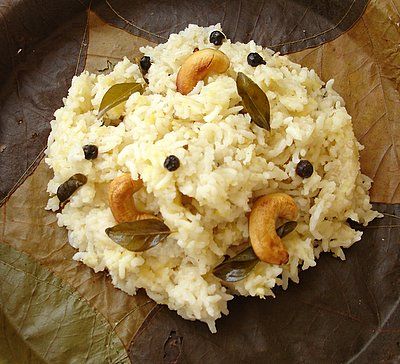
Spiritual Significance of Worshipping Bala Tripura Sundari during Navaratri
Bala Tripura Sundari, the radiant and youthful form of the divine mother, holds profound spiritual significance during Navaratri. Devotees turn to her seeking blessings that encompass beauty, wisdom, and inner transformation. Here’s an exploration of the spiritual depth of worshipping Bala Tripura Sundari during this auspicious festival:
1. Beauty of the Soul: Bala Tripura Sundari symbolizes the inherent beauty of the soul. Devotees believe that by connecting with her, they can uncover and embrace the innate beauty within themselves. Her divine grace helps individuals recognize that true beauty transcends the physical and is rooted in the purity of the heart.
2. Inner Transformation: The youthful goddess is a beacon of inner transformation. Her blessings are sought to navigate the journey of self-discovery and personal growth. By meditating upon her form and seeking her guidance, devotees aspire to shed their old, ego-driven selves and emerge as wiser, more compassionate beings.
3. Pursuit of Wisdom: Bala Tripura Sundari embodies wisdom and knowledge. Her blessings are sought to excel in scholarly pursuits, gain a deeper understanding of life’s mysteries and cultivate spiritual insight. Devotees turn to her to guide them on the path of enlightenment and the quest for higher wisdom.
4. Liberation from Illusions: The goddess is seen as a liberator from the illusions of the material world. Her devotees seek her aid in transcending the delusions and distractions that cloud their perception of reality. She is believed to grant clarity and the ability to perceive the world as it truly is.
5. Protection and Fearlessness: Bala Tripura Sundari’s symbolic gestures of fearlessness provide a sense of security and assurance to her devotees. By worshipping her during Navaratri, devotees feel protected from external threats and find the courage to face challenges with resilience.
6. Merging with the Divine: Ultimately, the spiritual significance of worshipping Bala Tripura Sundari during Navaratri lies in the desire to merge with the divine. Devotees believe that by invoking her presence and guidance, they can move closer to the ultimate reality and experience oneness with the cosmic consciousness.
In summary, Bala Tripura Sundari’s worship during Navaratri is a spiritual endeavor that goes beyond seeking transient blessings. It’s an exploration of the deeper dimensions of existence, an inquiry into the nature of beauty and wisdom and a journey towards inner transformation and self-realization. Devotees believe that by connecting with her, they can navigate the maze of life and emerge victorious in their spiritual journey.
Mantras and Prayers Dedicated to Bala Tripura Sundari
Devotees of Bala Tripura Sundari often turn to mantras and prayers to invoke her divine presence and seek her blessings for beauty, wisdom and inner transformation. These sacred invocations are powerful tools for connecting with the goddess on a spiritual level. Here are some mantras and prayers dedicated to Bala Tripura Sundari:
1. Bala Tripura Sundari Moola Mantra:
- Mantra: “ॐ ऐं ह्रीं श्रीं क्लीं बाला त्रिपुर सुंदर्यै नमः।” (Om Aim Hreem Shreem Kleem Bala Tripura Sundaryai Namah)
- Translation: “I bow to Bala Tripura Sundari, the beautiful goddess.”
2. Bala Tripura Sundari Gayatri Mantra:
- Mantra: “ॐ वाणीविद्यायै च विद्महे कामराजायै च धीमहि। तन्नो बाला प्रचोदयात्।” (Om Vanividyayai Cha Vidmahe Kamarajayai Cha Dheemahi, Tanno Bala Prachodayat)
- Translation: “May we meditate on the knowledge of speech and the desire of the Divine. May Bala guide and inspire us.”
3. Bala Tripura Sundari Ashtottara Shatanama Stotram:
- This is a hymn that praises Bala Tripura Sundari with 108 different names, invoking her various attributes and qualities.
4. Devi Kavacham:
- The Devi Kavacham is a protective prayer dedicated to the goddess. It can be recited to seek her blessings for safety, guidance and inner strength.
5. Lalita Sahasranama:
- While primarily dedicated to Goddess Lalita, this sacred hymn includes names and attributes that also apply to Bala Tripura Sundari. It is a powerful chant for invoking her grace and blessings.
6. Personal Prayers:
- Devotees can also offer their personal prayers to Bala Tripura Sundari, speaking from the heart and expressing their specific needs, aspirations and gratitude.
It’s important to approach these mantras and prayers with sincerity, devotion and a clear mind. Regular recitation and meditation on these sacred invocations can help individuals establish a deeper connection with Bala Tripura Sundari and experience the spiritual transformation and wisdom they seek.
The Cosmic Connection:
Navaratri, the celebration of the divine feminine, is not merely a terrestrial event; it resonates with cosmic significance. The nine nights symbolize the different phases of the moon and the celestial bodies that govern our existence. Bala Tripura Sundari’s radiant form is a reflection of cosmic beauty, and her presence during Navaratri aligns with the ebb and flow of celestial energies. Her worship is a harmonious dance between the terrestrial and celestial realms, reminding us of our profound connection with the cosmos.
Seeking Wisdom:
To seek wisdom and guidance from Bala Tripura Sundari, devotees can embark on a spiritual journey that transcends the boundaries of ordinary existence. Through meditation, reflection and inner exploration, individuals can tap into the wellspring of wisdom that resides within them. Bala Tripura Sundari, with her unwavering dedication to knowledge and spirituality, becomes a guiding star on this quest for self-discovery. Her blessings inspire us to delve deep into the recesses of our consciousness, illuminating the path to inner transformation and enlightenment.
Hidden within the folds of tradition and myth are lesser-known stories and teachings associated with Bala Tripura Sundari. These tales, often veiled in the mystical, offer profound insights into the goddess’s multifaceted nature. They reveal the secrets of beauty that transcends the physical, the wisdom that extends beyond the intellectual and the transformation that touches the very core of our being. Exploring these hidden gems of wisdom can enhance our understanding of the goddess and her role in our lives.
Conclusion:
In the mosaic of spirituality and devotion, Bala Tripura Sundari is a radiant thread, weaving beauty, wisdom and transformation into the lives of her devotees. Her significance extends beyond the boundaries of tradition, offering a cosmic perspective on existence.
As we conclude this journey, we find that her blessings are an eternal wellspring of inspiration, guiding us on a path of inner awakening and self-discovery. Bala Tripura Sundari invites us to explore the depths of our own beauty, wisdom and potential, ultimately leading us to the victory of the self over the illusions of the world. In her grace, we find the promise of a brighter, more enlightened future.
Author,
Sivalenka Neeraja

